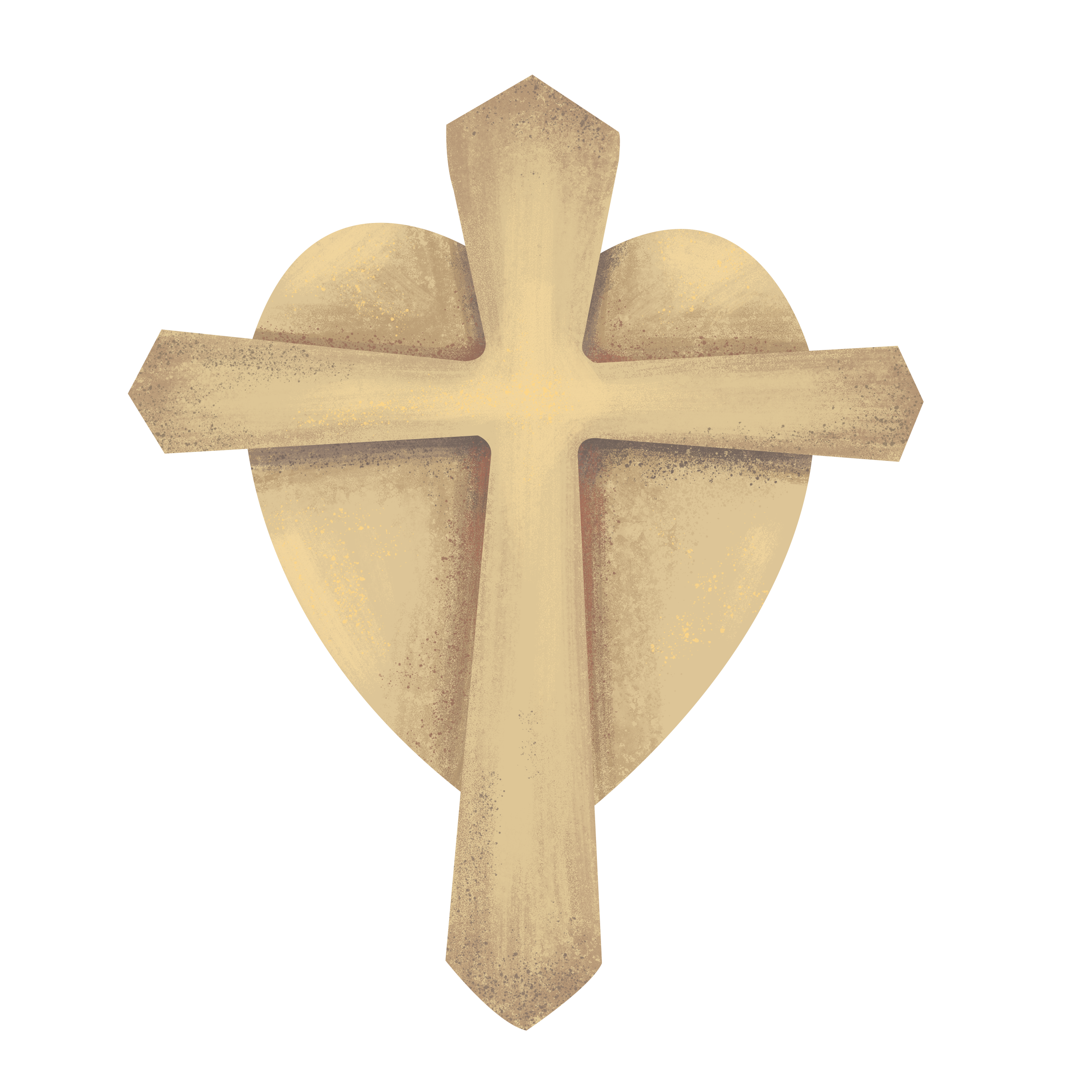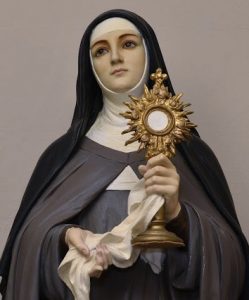 The Poor Clare Nuns were founded by St. Clare in the thirteenth century following the inspiration and example of St. Francis of Assisi, that is quite simply, “living according to the form of the Holy Gospel.” Thus, the Poor Clares are members of the great Franciscan family and are commonly known as the Second Order of St. Francis. Our community of Corpus Christi Monastery in Rockford follows the Colettine tradition, which originated in France in the fifteenth century. It was St. Colette of Corbie who initiated the reform, which took root and spread to many Poor Clare monasteries calling the nuns back to the original spirit of the Rule of St. Clare. We cherish our Franciscan heritage and the ancient observances of our Order as well as many unbroken traditions handed down to us through eight centuries of Poor Clare life.
The Poor Clare Nuns were founded by St. Clare in the thirteenth century following the inspiration and example of St. Francis of Assisi, that is quite simply, “living according to the form of the Holy Gospel.” Thus, the Poor Clares are members of the great Franciscan family and are commonly known as the Second Order of St. Francis. Our community of Corpus Christi Monastery in Rockford follows the Colettine tradition, which originated in France in the fifteenth century. It was St. Colette of Corbie who initiated the reform, which took root and spread to many Poor Clare monasteries calling the nuns back to the original spirit of the Rule of St. Clare. We cherish our Franciscan heritage and the ancient observances of our Order as well as many unbroken traditions handed down to us through eight centuries of Poor Clare life.
This continuity of our ‘Forma Vitae,’ tested by time, is evidence that it still expresses a timeless reality in our contemporary modern world. As loyal daughters of St. Clare who herself was a faithful daughter of the Church we dedicate ourselves to a constant striving to “sentire cum Ecclesia,” to be of one mind and heart with Holy Mother Church and all her teachings expressed by the Magisterium and the Vicar of Christ on Earth.
Who is St. Clare of Assisi?
Clare was born about the year 1193. Her mother was Ortolana di Fiumi and her father Faverone Offreduccio, and she had a younger sister, Agnes, and another, Beatrice, but of her childhood, adolescence and home-life there are no certain facts. When she was eighteen St. Francis came to preach the Lenten sermons at the church of San Giorgio in Assisi; his words fired her, she sought him out secretly, and he strengthened her nascent desire to leave all things for Christ. On Palm Sunday in the year 1212 Clare attended at the cathedral of Assisi for the blessing of palms; when all the rest went up to the altar-rails to receive their branch of olive a sudden shyness kept her in her place, which the bishop seeing, he went from the altar down to her and gave her the branch. In the evening she ran away from home and went a mile out of the town to the Portiuncula, where St. Francis lived with his little community. he and his brethren met her at the door of the chapel of our Lady of the Angels with lighted tapers in their hands, and before the altar she put off her fine clothes, and St. Francis cut off her hair, and gave her his penitential habit, which was a tunic of sackcloth tied about her with a cord. The holy father not having yet any nunnery of his own, placed her for the present in the Benedictine convent of St. Paul near Bastia, where she was affectionately received.
No sooner was her action made public but her friends and relations came in a body to draw her out of her retreat. St. Francis soon after removed her to another nunnery, that of Sant’ Angelo di Panzo. There her sister Agnes joined her, which drew on them both a fresh persecution. Agnes’s constancy proved at last victorious, and St. Francis gave her also the habit, though she was only fifteen years of age. Eventually St. Francis placed them in a poor house contiguous to the church of San Damiano, on the outskirts of Assisi, and appointed Clare the superior. . . .
Continue Reading . . .
She was later joined by her mother and others, among whom three were of the illustrious family of the Ubaldini in Florence.
St. Clare saw founded within a few years monasteries of her nuns at several places in Italy, France and Germany. St. Agnes, daughter to the King of Bohemia, founded a nunnery of the order in Prague, in which she took the habit. St. Clare and her community had neither stockings, shoes, sandals nor any other covering on their feet; they slept on the ground, observed perpetual abstinence from meat, and never spoke but when they were obliged by necessity and charity. St. Francis wished that his order should never possess any rents or other property even in common, subsisting on daily contributions, and St. Clare possessed this spirit in perfection. Pope Gregory IX desired to mitigate this part of her rule, and offered to settle a yearly revenue on the Poor Ladies of San Damiano; but she persuaded him to leave her order in its first rigorous establishment. Gregory accordingly granted in 1228 the Privilegium paupertatis, that they might not be constrained by anyone to accept possessions. The convents of Perugia and Florence also received this privilege, but others thought it more prudent to accept a mitigation. After the death of Gregory IX (who as Cardinal Ugolino had drawn up the first written rule for the Poor Ladies of San Damiano), Innocent IV in 1247 published another recension of the rule which in some respects brought it nearer to Franciscan than to Benedictine observance, but which permitted the holding of property in common; he wrote that he did not wish to force this rule on any community unwilling to accept it. St. Clare was unwilling, and she set to work to draw up a rule which should unequivocally provide that the sisters possess no property, either as individuals or as a community. It was not until two days before she died that this rule was approved for the convent of San Damiano by Pope Innocent IV.
From the time when she was appointed abbess, much against her will, by St. Francis in 1215, St. Clare governed the convent for forty years. Thomas of Celano, who often heard St. Francis warning his followers to avoid any injudicious association with the Poor Ladies, states categorically that St. Clare never left the walls of San Damiano. Unhappily even during her life, and for long after her death at intervals, there was disagreement between the Poor Clares and the Friars Minor as to the relations of the two orders: the observant Clares maintaining that the friars were under obligation to serve them in things both spiritual and temporal.
St. Clare bore years of sickness with sublime patience, and at last in 1253 the long-drawn-out agony began. Twice during its course she was visited by Pope Innocent IV, who gave her absolution. She died the day after the feast of St. Laurence, the forty-second year after her religious profession, and the sixtieth of her age. She was buried on the day following, on which the Church keeps her festival. Pope Alexander IV canonized her at Anagni in 1255.
from Butler’s Lives of Saints © Harper Collins
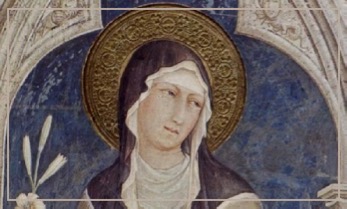
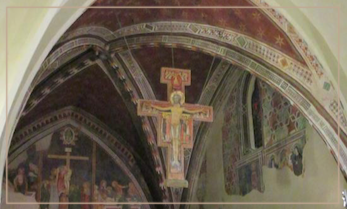
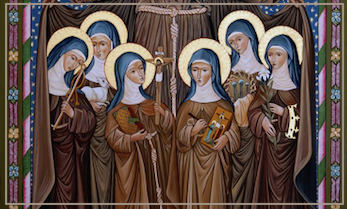
Who is St. Colette of Corbie?
On February 7th we celebrate the feast day of Saint Colette (1381-1447), virgin, reformer of the Franciscan Order of Poor Clares, and unifier of the Church.
All human institutions, however excellent, are apt to degenerate after the death of their founders or the immediate successors of those founders. If they are to continue they need to be reanimated with their original ideals or else remodelled to bring them up to date. We find this with the great religious orders, which all have their ups and downs, their periods of activity and eclipse, and it is as the reformer of one of the most austere of these families, the Poor Clares, that St Colette did her chief work in the world. The impression she made upon her order was very great, and one branch still bears after her the name of Colettines. The circumstances of her birth were humble, her father being a carpenter at the abbey of Corbie in Picardy ; her parents were devout people who gave to their little girl the name of Nicolette, in honour of St Nicholas of Myra. Colette, as she was called, was a singularly attractive child, very lovely to behold, but so tiny that her father was quite concerned about it. The child prayed that she might grow taller, and her prayer was answered. . . .
Continue Reading . . .
As she grew older she lived at home almost as a solitary, busying herself with prayer and manual work, and her parents, recognizing that she was led by the spirit of God, allowed her full liberty. Nevertheless, even in her retirement, her beauty attracted so much attention that Colette, finding, it a hindrance, prayed that her complexion might be changed, and we read that her face became so thin and pale that she was scarcely recognizable, but that her sweet and modest demeanour continued to make her singularly attractive to all who saw her. Both her parents died when Colette was seventeen, leaving her under the care of the abbot of Corbie ; after a time in a convent, she distributed to the poor the little she had inherited and entered the third order of St Francis. The abbot gave her a small hermitage beside the church of Corbie, where she lived a life of such austerity that her fame spread far and wide and many sought her prayers and advice. After a while, however, she received no more visitors, and for three years maintained complete silence and seclusion. Doubtless during that period she had pondered much over the condition of the order to which she was affiliated and had spoken of it to her confessor, Friar Henry de Baume, for we read that he dreamt he saw Colette tending a vine covered with leaves but fruitless, and that after she had pruned it began to bear an abundance of grapes.
Colette herself also had visions, in one of which the Seraphic Father St Francis appeared and charged her to restore the first rule of St Clare in all its original severity. Not unnaturally, she hesitated, but she received what she recognized as a sign from Heaven when she was struck blind for three days and dumb for three days more. Encouraged by her director, she left her cell in 1406, and straightway made an attempt to explain her mission in one or two convents, but soon discovered that, if she was to succeed, she must be invested with the proper authority. Barefoot, dressed in a habit made up of patches, Colette set out for Nice to seek Peter de Luna, who at that epoch of the great schism was acknowledged by the French as pope, under the name of Benedict XIII. He received her with great consideration, and not only professed her under the rule of St Clare, but was so much impressed that he constituted her superioress of all convents of Minoresses that she might reform or found, with a mission to the friars and tertiaries of St Francis as well. At the same time he appointed Father Henry de Baume to act as her assistant.
Armed with these powers, St Colette went from convent to convent, travelling through France, Savoy and Flanders, and at first she met with violent opposition, being treated as a fanatic and even accused of sorcery. But rebuffs, ill-will, and calumnies were all alike received with joy, and after a while she began to meet with a more favourable reception, especially in Savoy, where her reform gained both sympathizers and recruits, and from thence it passed to Burgundy, France, Flanders and Spain. Besancon was the first house of Poor Clares to receive her revised rule, in 141 o. Her fame spread far and wide and was enhanced by the many miracles she wrought. ” I am dying to see that wonderful Colette who raises people from the dead “, wrote the Duchess of Bourbon. She saw her, and no family was more deeply influenced by the saint. This peasant woman exercised a singular spell over people of high rank in the world, like Blanche of Geneva, the Duchess of Nevers, Amadeus II of Savoy, the Princess of Orange, and Philip the Good, Duke of Burgundy.
It is said that, as Colette made a stay at Moulins in 1429, she met St Joan of Arc on her way with an army to besiege La Charite-sur- Loire, and one would be pleased to imagine an interview between these two remarkable women, so unlike in their missions but so similar in their spirit. Unfortunately no evidence exists of any personal intercourse between them. One place closely connected with St Colette is Le Puy-en-Velay, where her convent has had an unbroken life to this day. Altogether she founded seventeen new convents, besides reforming numerous old ones, and several houses of Franciscan friars accepted her reform.
Underlying all her external activity was St Colette’s life of prayer which sustained her throughout her whole career. She beheld our Lord in a vision suffering and dying on the cross, and always on Fridays, from six in the morning until six in the evening, she meditated unceasingly on the Passion, neither eating nor drinking nor doing anything else. In Holy Week particularly, but also at other seasons, she would be rapt in ecstasy when assisting at Mass or when praying in her cell, which was sometimes irradiated with a supernatural light, whilst her own countenance shone with celestial brightness. Almost always after holy communion she was rapt in an ecstasy which lasted for many hours. Once she had a vision of men and women falling from grace in appalling numbers, like the flakes in a snowstorm, and ever afterwards she would daily pour forth fervent prayer for the conversion of sinners and for the souls in Purgatory : indeed we read that she actually died in a transport of intercession for sinners and for the Church.
Like her spiritual father St Francis, Colette was a lover of animals, especially of those that are weak and gentle : lambs and doves she would gather round her and the shyest of birds would eat out of her hand. For children too she had a great affection, and she liked to play with them and to bless them — as her Saviour had done.
It was in Flanders, where she had established several houses, that St Colette was seized with her last illness. She foretold her own death, received the last sacraments and died in her convent at Ghent in her sixty-seventh year. Her body was removed from Ghent by the Poor Clares when the Emperor Joseph II was suppressing a number of religious houses in Flanders, and borne to her convent at Poligny, thirty-two miles from Besancon. She was canonized in 1807.
Although much manuscript material for the history of St Colette which is known to have existed in the sixteenth century has now disappeared, we are not destitute of contemporary and first-hand sources. The text of the narrative of Father Henry de Baume, her confessor for thirty- three years, seems to have been lost, as also the memoirs of Fr Francis Claret, another of her spiritual guides, but the record compiled by her devoted friend and daughter in religion, Sister Perrine, still survives. Moreover, we have a good number of the saint’s own letters and the copious but disjointed recollections of Fr Peter de Vaux, her confessor in her last years. It is interesting to note that a copy of this life by Peter de Vaux was made and richly illuminated by command of Margaret, Duchess of Burgundy, who was the sister of Edward IV, King of England. She presented it to a convent of Colettines and wrote at the end in her own hand, ” Votre Loyal fylle Margarete d’ Angle terre ; priez pour elle et pour son salut “. This manuscript is now in the convent of the Poor Clares at Ghent. The lives by Sister Perrine and Peter de Vaux, formerly printed in a Latin translation by the Bollandists, together with some extracts from the processes, have been edited by Fr Ubald d’Alencon in the language in which they were written (191 1). In modern times we have biographies by Bizouart, Germain, Pidoux, Imle and Poirot. See also some valuable notes by Ubald d’Alencon in the Archivum Franciscanum Historicum, vols, ii and iii (1909-1910), The admirable biography of the saint by Mme Sainte-Marie Perrin has been translated into English with some useful additions (1923), as has the life by Fr Sellier (1864).
from Butler’s Lives of Saints © Harper Collins
